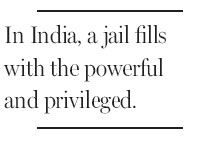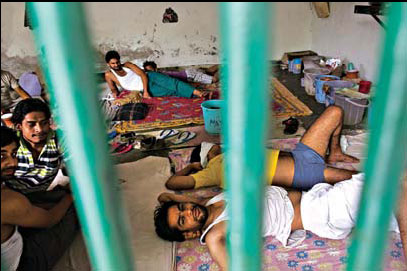Society
Rehabilitation for prison and inmates
Updated: 2011-07-31 08:28
By Lydia Polgreen (The New York Times)
|
India's Tihar jail was once corrupt, but it now focuses on rehabilitation and equal treatment of prisoners. India's court backlog has resulted in overcrowding. Lynsey Addario for The New York Times |
NEW DELHI - At least two prime ministers have spent a few nights behind its high walls. Its current occupants include three members of Parliament, a top bureaucrat and one of India's richest men.
In an unprecedented season of seething public anger over accusations of widespread corruption, a growing number of senior politicians and wealthy businessmen have ended up in the sprawling Tihar jail complex, which sits on 160 hectares on the western edge of New Delhi.
They include men like A. Raja, the former telecommunications minister who presided over the sale of valuable cellphone spectrum, costing the Indian treasury as much as $40 billion. He sleeps on the floor in Jail 1.
Suresh Kalmadi, a major figure in the governing Congress Party, is holed up in Jail 4. He was in charge of the shoddy preparations for the Commonwealth Games last year and stands accused of making millions in kickbacks.
In Jail 3, a handful of telecommunications executives, including Shahid Usman Balwa, part of India's growing class of billionaires, are awaiting trial.
Women are here, too. In Jail 6 is Kanimozi, a member of the upper house of Parliament and daughter of one of the most powerful political figures in southern India, accused of taking bribes in the telecommunications scandal.
In a nation where status buys almost anything, elite inmates ask for perks all the time: air-conditioners for their cells; food from home every day. But almost all such requests have been denied, jail officials said.
None of these accused have yet been convicted; indeed, trials in most of their cases have yet to begin. But all have been denied bail, and must sweat out their wait in their sweltering cells.
Tihar was built in 1958, and its design followed the idealism of newly independent India. Its vast campus was intended to look more like a high security college campus than a notorious prison.

But as India grew poorer and more corrupt in the 1960s and 70s, conditions at Tihar deteriorated.
In her book about her time running Tihar jail, "It's Always Possible," Kiran Bedi, a former senior police official turned anticorruption crusader, wrote of how the jail had its own officially sanctioned caste system, which put white-collar prisoners at the top of the hierarchy. The upper echelons ate separately and got better food. They were entitled to more sugar for their tea.
But in 1997, the system was dismantled by a Supreme Court judgment. Nowadays, the jail has largely returned to its more idealistic roots. There are art studios, computer labs and libraries. There is a factory where convicts learn vocational skills.
The jail is still crowded, particularly the open barracks where most of the prisoners awaiting trial live. India's clogged court system has a huge backlog of cases.
Most of the other cells were originally designed for one prisoner, but they usually hold at least three. The jail's official capacity is 6,250, but it currently houses more than 12,000.
"Whenever you find two Indians you will find mischief," said Sunil Kumar Gupta, the jail's spokesman, explaining that it is jail policy never to put just two people in a cell. "If the two are creating mischief, the third will inform the jail authorities."
A convict from Mumbai who is a decade into a 14-year drug-smuggling sentence said life in the jail is much improved since he first arrived.
His cell, which he shared with three other men, had a television and cable connection, which is allowed by current jail rules.
"Would you like some tea?" he asked a visitor. Inside the cell were teacups and an electric kettle, arranged on a doily.
Certain privileges have been extended to the jail's highest profile prisoners. Kanimozi's husband, a wealthy Singapore-based businessman, was ushered in to visit her well past visiting hours one summer afternoon. A jail official shrugged when asked about this discrepancy. His phone rang nonstop with such requests, and it was hard to refuse them all.
"What can we do?" he said.
The New York Times
E-paper

Double vision
Prosperous Hangzhou banks on creative energies to bridge traditional and modern sectors
Minding matters
A touch of glass
No longer going by the book
Specials

Carrier set for maiden voyage
China is refitting an obsolete aircraft carrier bought from Ukraine for research and training purposes.

Pulling heart strings
The 5,000-year-old guqin holds a special place for both european and Chinese music lovers

Fit to a tea
Sixth-generation member of tea family brews up new ideas to modernize a time-honored business

